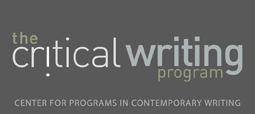Architecture
An Overview of the Discipline
Architecture is the art or practice of designing and constructing buildings. The discipline of architecture can be divided into two sub-disciplines: the theoretical sub-discipline and the professional sub-discipline. Academic theoretical writing tends to examines the history of design and architecture. Professional writing primarily takes place in the private sector and is tailored to clientele.
Writing in the Discipline
Reasoning
With respect to reasoning, there is a divide in architectural writing between theoretical writing and professional writing. Theoretical writing, similar to the writing in the discipline of art history, makes use of explanatory reasoning, whereas professional writing, the writing involved in the practice of architecture, employs a mix of justificatory and explanatory reasoning. Examples of professional writing in architecture include brochures, position papers on design, and architectural plans and proposals.
Evidence
Those in the discipline of architecture consider both data- and text-based evidence to be legitimate. The legitimacy of the evidence depends on the sub-discipline. On the one hand, if the writing aims at the humanistic form of architecture, evidence will be primarily text-based. On the other hand, if writing aims at the professional form of architecture, evidence will be primarily data-based. Clients of architects frequently want to know the measurements and costs of a project before they commit to it. For instance, a client would want to check the dimensions and cost of the addition to their house to assure that they are the desired dimensions within the budget range before they commit the funds to the project.
Authorship
Scholarly work in the field of Architecture is mostly single-authored. Many publications are anthologies of single-authored works.
Goal
Similar to evidence in architectural writing, the goal of the writing also depends on which sub-discipline the writing falls under. If the writing falls under the humanistic sub-discipline, the goal of the writing, as Annette Fierro observes, is to "better understand a set of circumstances (i.e. technological, historical, political, etc.) or historical event with a new, critical lens" by affirming or critiquing a position. If the writing falls under the professional sub-discipline, the goal of the writing is define a problem and design a solution.
Writing Tips
Important Criteria for Student Writing
The most important criteria for writing in architecture are:
- Reasoning and evidence
- Organization
- Having original ideas
Common Errors
- Gross simplification. Understanding the causes and effects of an era of architecture and not oversimplifying them is extremely important. According to Professor Braham, an example of oversimplification might be that the collapse of the Roman Empire led to the birth of the renaissance, which, in effect, led to the buildings of the period taking on square shapes. This example demonstrates an oversimplification of the causes behind the square-shaped buildings that followed the renaissance. There exist many other factors behind the square shapes besides the fall of the Roman Empire or the birth of the Renaissance that should be taken into account.
- Incorrectly identifying the audience. Frequently the audience is assumed to be the professor when, in reality, the audience could be very different from the professor, according to Professor Trubiano. For example, a professionally oriented course could have the clientele as the audience, or a more theoretically oriented course could have the student’s colleagues as the audience.
- Not correctly citing sources or scholars' arguments.
- Common grammar mistakes.
Claims
Claims in architecture can be difficult to validate because of architecture’s unique blend of science and art. When examining the science aspect of architecture (i.e. building, construction, and environmental science), the validation of claims is similar to that of any other science. But, as Dr. Trubiano points out, "because architecture is also a design practice it is difficult to suggest that there are invalid claims in design since a great deal of it is based on visual rhetoric."
Style Preferences
There is no single citation style used in the field of architecture. Those working in the professional sub-discipline of architecture will frequently use citation styles similar to those used by engineers, while those working in the theoretical sub-discipline will use Chicago manual or MLA.
Genre
Student Assignments
Writing assignments in architecture consist of longer 10-12 page papers, shorter papers, design projects, and presentations. The papers tend to focus more on the theoretical side of architecture, which according to Dr. Trubiano requires the student to argue one interpretation or another of a building case study. The design projects and presentations tend to focus more on the professional side of architecture.
Professional Writing
Professional writing in architecture includes brochures, position papers on design, and architectural plans and proposals. Professional writing can fall under both sub-disciplines of architecture, theoretical and professional.
Additional Resources
- Alexandra Lange's Writing about Architecture: Mastering the Language of Buildings and Cities
© 2013-2014 The University of Pennsylvania
Meet the Professors
 Dr. Franca Trubiano
Dr. Franca Trubiano
Dr. Trubiano likes to make a list or map of her ideas before writing. More...
 Dr. William Braham
Dr. William Braham
Dr. Braham begins by creating a sentence that encompasses the problem he aims to address. More...
 Annette Fierro
Annette Fierro
Fierro generates potential themes for her writing by mapping out her reasearch on the wall. More...
